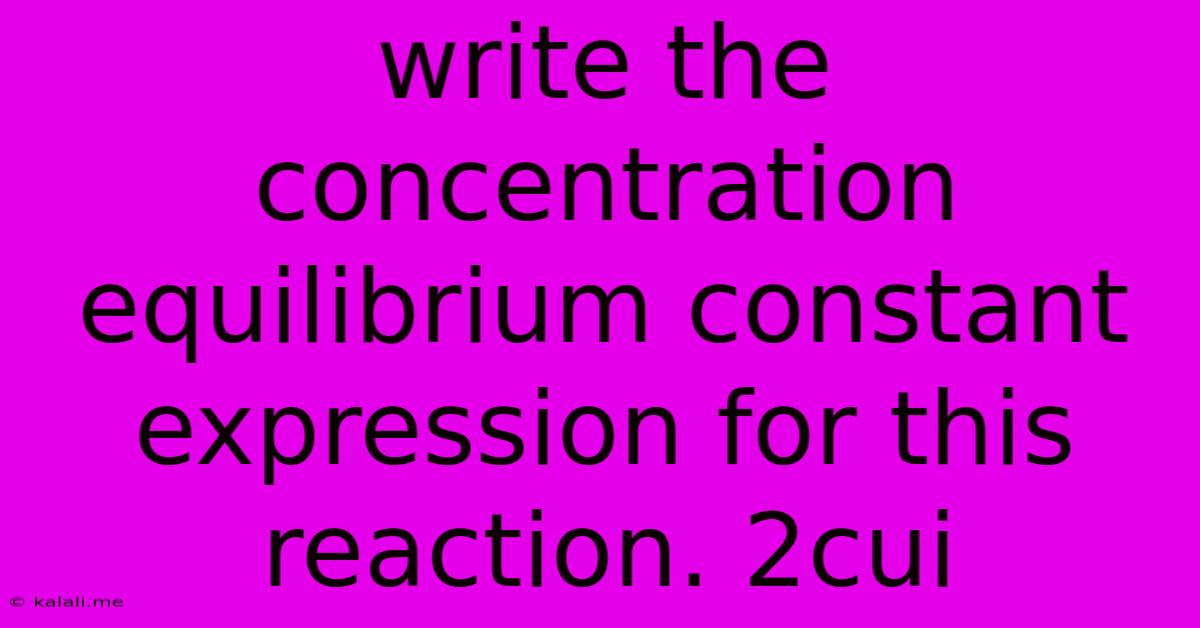Write The Concentration Equilibrium Constant Expression For This Reaction. 2cui
Kalali
May 09, 2025 · 2 min read

Table of Contents
Writing the Concentration Equilibrium Constant Expression: A Comprehensive Guide
This article will guide you through the process of writing the concentration equilibrium constant expression, specifically focusing on the example reaction: 2CuI(s) ⇌ 2Cu⁺(aq) + 2I⁻(aq). Understanding equilibrium constants is crucial in chemistry, allowing us to predict the direction and extent of a reaction. This explanation will cover the fundamentals and provide a clear, step-by-step approach.
What is the Equilibrium Constant (Kc)?
The equilibrium constant, Kc, is a value that describes the ratio of products to reactants at equilibrium for a reversible reaction at a given temperature. A large Kc value indicates that the equilibrium favors the formation of products, while a small Kc value suggests the equilibrium favors the reactants. It's important to remember that Kc is temperature-dependent; changing the temperature will alter the value of Kc.
Understanding the Reaction: 2CuI(s) ⇌ 2Cu⁺(aq) + 2I⁻(aq)
This reaction shows the dissolution of cuprous iodide (CuI) in water. CuI is a solid (s), while Cu⁺ and I⁻ are aqueous ions (aq). The double arrow (⇌) signifies that the reaction is reversible; it proceeds in both the forward (dissolution) and reverse (precipitation) directions.
Writing the Kc Expression
The general formula for the concentration equilibrium constant (Kc) is:
Kc = ([Products]) / ([Reactants])
where the square brackets [ ] denote the molar concentration of each species. However, there are important considerations:
-
Solids and Liquids: Pure solids and liquids are not included in the Kc expression. Their concentrations remain essentially constant throughout the reaction. Therefore, solid CuI is excluded.
-
Coefficients: The stoichiometric coefficients in the balanced chemical equation become exponents in the Kc expression.
Applying these rules to our reaction:
Kc = [Cu⁺]²[I⁻]²
Step-by-Step Explanation:
-
Identify Products: The products are Cu⁺(aq) and I⁻(aq).
-
Identify Reactants: The reactant is CuI(s), but it's excluded from the expression because it's a solid.
-
Apply Coefficients as Exponents: The coefficients of Cu⁺ and I⁻ are both 2, so their concentrations are raised to the power of 2.
-
Construct the Expression: Combining the concentrations of the products, we get the final Kc expression: Kc = [Cu⁺]²[I⁻]².
Significance of the Kc Expression
This Kc expression allows us to quantitatively determine the relationship between the concentrations of copper(I) ions and iodide ions at equilibrium in a saturated solution of cuprous iodide. Knowing the value of Kc for this reaction allows us to calculate the solubility of CuI. A higher Kc indicates greater solubility.
Conclusion
Writing the concentration equilibrium constant expression involves a systematic process. Remember to exclude pure solids and liquids, and use the stoichiometric coefficients as exponents. Understanding this process is fundamental to mastering equilibrium calculations and interpreting chemical reactions. This approach can be extended to other equilibrium reactions, providing a valuable tool for chemical analysis and prediction.
Latest Posts
Latest Posts
-
How Many Fahrenheit Equals 1 Celsius
May 09, 2025
-
What Is 30 As A Fraction
May 09, 2025
-
22 7 As A Mixed Number
May 09, 2025
-
How Many Cups Is 20 Fluid Ounces
May 09, 2025
-
What Is 6 Fl Oz In Cups
May 09, 2025
Related Post
Thank you for visiting our website which covers about Write The Concentration Equilibrium Constant Expression For This Reaction. 2cui . We hope the information provided has been useful to you. Feel free to contact us if you have any questions or need further assistance. See you next time and don't miss to bookmark.